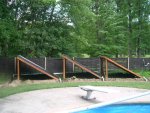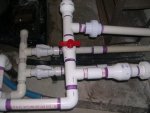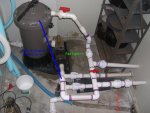I originally posted this as an addition to this thread: solar-panel-and-rack-design-help-t12214.html
I need help from the plumbing/hydraulics experts, so I decided to split it off to a new topic.
I recently added (12) 2x10 Sungrabber solar panels to my system, mounted across (3) racks. The racks are ~60' from my pump, so there's 60' of 2" pipe there, and 60' back.
[attachment=0:35pf4jzk]racks_pipe.jpg[/attachment:35pf4jzk]
My filter pressure increased by 8psi after the install. The pressure increases by another 2psi when I divert all of the water to the panels.
When I sent water to the panels, the front 2 panels (the one in the middle, and to the right in the picture), cooled down and I felt warm water coming from the returns. The panel to the left stayed hot. I closed the valve going to the right panel, and heard the left panel fill with water and felt it cool down. I opened the valve about halfway on the right panel and it cooled down a bit, but still felt warm to the touch. The panel on the left went from cold to lukewarm. I measured the pipes for all three racks from where they split off of the common send pipe until the rejoin the common return pipe. The left rack has 26' of pipe, the middle rack has 24', and the right rack has 26', so the water shouldn't really favor one rack over the others, right?
Any I ideas what the problem might be, or a solution? I'm thinking it's not the best solution to damper the valve at the right rack, because then it's not getting full flow. Is this line of thinking correct? Is my pump not strong enough? I've always thought 1.5hp was plenty of power. How can I tell if this is a fully rated 1.5hp pump?
The label on my pump has the following info:
Century 1081 Pool Pump Duty
Part #: 8-168099-02 - FR M 56J - Type CX
HP 1.5 - RPM 3450 - HZ 60
PH 1 - SF 1.00 - Volts 230/115 - Amps 7.2/14.4
Time Cont - AMB 40* C - Insul Class B - ENCL DP
Code E - Thermally Protected KA - Form K JM - Serial BD4
Thanks for reading this long post!
I need help from the plumbing/hydraulics experts, so I decided to split it off to a new topic.
I recently added (12) 2x10 Sungrabber solar panels to my system, mounted across (3) racks. The racks are ~60' from my pump, so there's 60' of 2" pipe there, and 60' back.
[attachment=0:35pf4jzk]racks_pipe.jpg[/attachment:35pf4jzk]
My filter pressure increased by 8psi after the install. The pressure increases by another 2psi when I divert all of the water to the panels.
When I sent water to the panels, the front 2 panels (the one in the middle, and to the right in the picture), cooled down and I felt warm water coming from the returns. The panel to the left stayed hot. I closed the valve going to the right panel, and heard the left panel fill with water and felt it cool down. I opened the valve about halfway on the right panel and it cooled down a bit, but still felt warm to the touch. The panel on the left went from cold to lukewarm. I measured the pipes for all three racks from where they split off of the common send pipe until the rejoin the common return pipe. The left rack has 26' of pipe, the middle rack has 24', and the right rack has 26', so the water shouldn't really favor one rack over the others, right?
Any I ideas what the problem might be, or a solution? I'm thinking it's not the best solution to damper the valve at the right rack, because then it's not getting full flow. Is this line of thinking correct? Is my pump not strong enough? I've always thought 1.5hp was plenty of power. How can I tell if this is a fully rated 1.5hp pump?
The label on my pump has the following info:
Century 1081 Pool Pump Duty
Part #: 8-168099-02 - FR M 56J - Type CX
HP 1.5 - RPM 3450 - HZ 60
PH 1 - SF 1.00 - Volts 230/115 - Amps 7.2/14.4
Time Cont - AMB 40* C - Insul Class B - ENCL DP
Code E - Thermally Protected KA - Form K JM - Serial BD4
Thanks for reading this long post!







